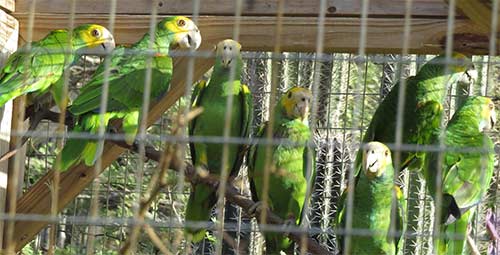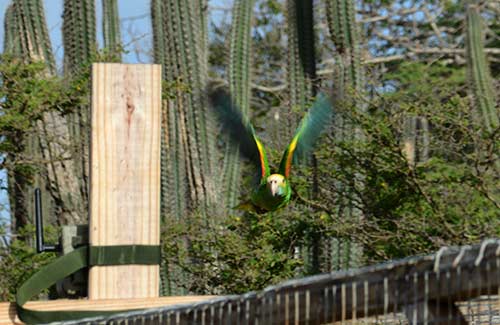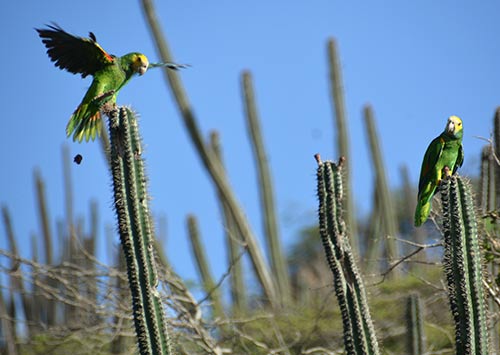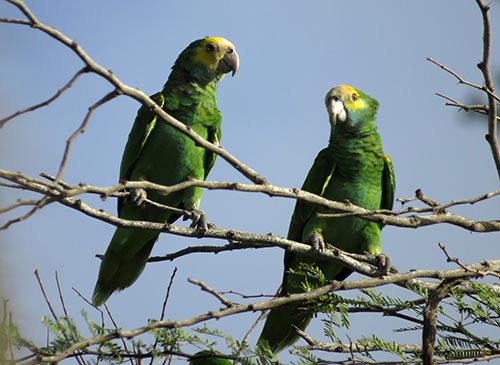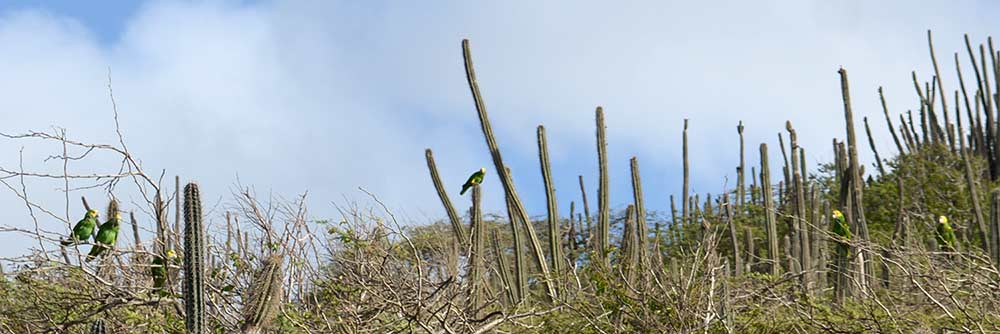Bonaire’s Parrot Population Rises by 7
Captive-born parrots are released into the wild.
Posted July 22, 2020
Echo Foundation releases six captive-born Yellow-shouldered Parrots, as well as one rehabilitated parrot.
On Saturday morning, July 18, 2020, a few humans joined together with smiles on their faces as six captive-born parrots, along with one rehabilitated parrot, stretched their wings for the first time.
Six Parrots were born in captivity.
Echo Foundation has at its core mission the survival of Bonaire’s endemic subspecies of the Yellow-Shouldered Parrot, a subspecies found only on Bonaire. Still considered vulnerable, Bonaire’s lora, as it is locally called, is making a slow but steady comeback.
There are several adult parrots that are in permanent residency at Echo’s Conservation Centre because they can no longer fly. However, their inability to fly does not lessen their ability to procreate, and just over a year ago, two pair-bonded couples–Mrs. Pink and Bruce, along with Sylvia and Earl–parented a clutch with three successful hatchlings from each pair, creating six captive-born parrots.
The six young parrots grew, and Echo took care of them. As they matured, they were put into a large flight cage so that they could strengthen their wings. After about one year, they were ready (and willing) to head out into the wild on their own.
One Parrot was rehabilitated.
The seventh parrot released on Saturday was born in the wild, but suffered a minor injury and thus was rehabilitating at the Echo Conservation Centre. It was also ready to be released back into its native habitat.
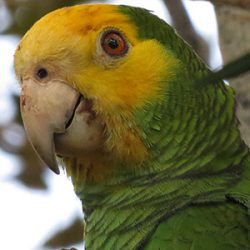
Geelvleugelamazone (papegaai)
(Amazona barbadensis)
Dieet: Voedt zich met vruchten, zaden en cactusbloemen.
Voortplanting: Legt 3 of 4 eieren
Status: Kwetsbaar
The release of the captive-born parrots.
As the skyward opening was moved back, it took about seven minutes (this interim section has been fast-forwarded in the video for viewing convenience) for the parrots to “discover” the opening and then cautiously explore the additional space.
One parrot left on its own, the first to discover the space. After alighting on a nearby cactus for a few seconds, it quickly took off for parts unknown as it winged its way into the eastern sky. It is quite probable that this parrot was the rehabilitated one, as it was quite comfortable outside of the flight cage.
The six captive-born parrots needed a little more encouragement to “fly the coop.” Julianka Clarenda, Echo’s director, quietly waved a leaf-laden bough softly towards the opening, encouraging the remaining parrots to find and explore their new world.
The first three, most likely clutch-mates, found the opening and climbed on top of the flight cage. Soon, they took off and landed in near-by cacti.
The final three captive-born parrots witnessed this and quickly made their way out of the flight cage. They also alighted on near-by cacti.
The six parrots immediately began to get accustomed to their new habitat. One immediately began eating the fruit of the cactus, and it promptly knocked the fruit to the ground. It will learn.
The six captive-born parrots stayed in and around the area of the flight cage for some time, while getting their bearings. Echo kept the flight cage open for 24 hours, in case the released parrots needed a “safe place” while they acclimated. It would also provide safety in the case of a flyover by a Crested Caracara, which happened while we were watching. The Crested Caracara is a bird of prey, and although it prefers carrion, it does actively hunt. Food was also provided outside the flight cage in case the parrots needed some assistance in feeding.
With smiles on our faces, we congratulated Julianka on successfully bringing these vulnerable parrots to adulthood. Bonaire is very lucky to have excellent organizations such as Echo that assist in preserving and conserving the island’s nature.
About Echo Foundation.
Echo’s mission statement is to plant, protect, and grow the future for parrots AND people.
They are active in educational efforts, research, and monitoring measures (as in this weekend’s mid-year Parrot Count).
To provide additional habitat for Bonaire’s vulnerable Yellow-Shouldered Parrot, the organization is active in reforestation efforts in many areas in the north of the island, in the dry forest that is the parrots’ favorite habitat.
About the author
Susan has been living on Bonaire for over 30 years. She is a certified bird guide, a PADI SCUBA Diving Master Instructor, and an underwater and topside photographer.
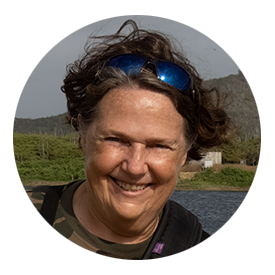
Get in touch with Susan
Contact Susan via email, Facebook Messenger, call Susan or use the online form below.
If you have any questions about your Bonaire birding tour, feel free to contact Susan for answers. She is always willing to go into more detail about routes or the best times for a tour based on your personal preferences. Tours can be tailored to your interests, whether that be birds, photography, or both!
It is also a good idea to do some homework on the birds of Bonaire before you come. Knowing a little about the birds you might encounter on your tour will make your experience even more enjoyable!
Be sure to check out these resources for birding on Bonaire. Also, reading the Bird Blog will introduce you to the birds that might be observed on Bonaire.
Get In Touch
Get in touch with Susan to check availability for the dates you are visiting Bonaire.
Consent: By using this form you agree with the storage and handling of your data by this website.

